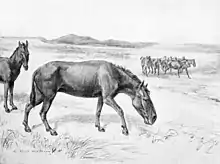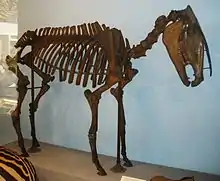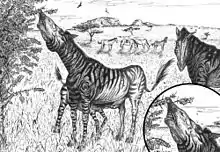Hippidion
Hippidion (meaning little horse) is an extinct genus of equine that lived in South America from the Late Pliocene to the end of the Late Pleistocene (Lujanian), between 2.5 million and 11,000 years ago. They were one of two lineages of equines native to South America during the Pleistocene epoch, alongside Equus (Amerhippus) neogeus.
| Hippidion | |
|---|---|
 | |
| H. principale skeleton | |
| Scientific classification | |
| Domain: | Eukaryota |
| Kingdom: | Animalia |
| Phylum: | Chordata |
| Class: | Mammalia |
| Order: | Perissodactyla |
| Family: | Equidae |
| Subfamily: | Equinae |
| Tribe: | Equini |
| Genus: | †Hippidion Owen, 1869 |
| Species | |
| |
| Synonyms | |
Taxonomy
Evolution

Hippidion has been considered a descendant of pliohippines,[1] equines that migrated into the South American continent around 2.5 million years ago.[1][2] Early analysis of the ancient DNA of Hippidion and other New World Pleistocene equines supported the novel hypothesis that Hippidion was actually a member of the living genus Equus, with a particularly close relationship to the wild horse, Equus ferus.[1][2] However this was later shown to be incorrect, with more complete sequences finding Hippidion as an outgroup to all living equines[3] and less closely related to living equines than the "New World stilt legged horse", Haringtonhippus francisci.[4]
Hippidion is traditionally thought to have 3 species, H. principale, H. saldiasi and H. devillei, however, in a 2015 DNA analysis, the single sampled H. principale specimen was found to be nested with H. saldiasi, with H. devillei found to be clearly genetically distinct.[3]
Description

It stood approximately 1.4 metres (4.6 ft) (also 13.2 hh) high at the shoulders and resembled a donkey. The skull of Hippidion is noted for its nasal bone, which projects forward from the skull.[5]
Paleobiology

A study found that Late Pleistocene specimens of Hippidion had lower δ13C values than those of specimens of Amerhippus, indicating a preference for C3 woodland and wooded open habitats.[5] H. principale is suggested to have been a mixed feeder (both browsing and grazing), as opposed to the grazing diet of the contemporary Equus neogeus.[6]
Distribution
Remains of Hippidion saldiasi have been recovered in locations such as the Piedra Museo site, Santa Cruz, Argentina[7] and Cueva del Milodon, Chile.[8] The significance of such archaeological recovery is amplified by the association with hunting of these animals by prehistoric man at possible Pre-Clovis horizons.
Fossils of Hippidion have been found in:[9][5]
- Pleistocene
- Tarija, Ñuapua and Ulloma Formations, Bolivia
- Jandaíra Formation, Brazil
- Chíu-Chíu Formation, Cueva del Milodón, Chile
- Tierra del Fuego, Magallanes Province and its borders with Argentine[10]
- Sopas and Dolores Formations, Uruguay
- Taima-Taima, Venezuela
Extinction
Hippidion became extinct alongside the other South American equines at the end of the Late Pleistocene, between 12,000 and 10,000 years Before Present (BP) as part of the Quaternary extinction event, which resulted in the extinction of most large animals in both North and South America. Climatic modelling suggests that the preferred habitat for species of Hippidion declined after the Holocene transition, but the decline is not enough to explain the extinction.[11] At the Arroyo Seco 2 site in the Argentinan Pampas (14,782–11,142 cal yr BP), and Piedra Museo site in Santa Cruz Province, Patagonia (two separate layers dating to 12,463–10,457 cal yr BP and 15,517–12,352 cal yr BP), remains of Hippidion are associated with human artifacts, including Fishtail projectile points, and bear cut marks, indicating that they were hunted by recently arrived humans, which may have played a role in their extinction.[12]
References
- Weinstock, J.; et al. (2005). "Evolution, systematics, and phylogeography of Pleistocene horses in the New World: a molecular perspective". PLOS Biology. 3 (8): e241. doi:10.1371/journal.pbio.0030241. PMC 1159165. PMID 15974804.
- Orlando, L.; et al. (2008). "Ancient DNA Clarifies the Evolutionary History of American Late Pleistocene Equids". Journal of Molecular Evolution. 66 (5): 533–538. Bibcode:2008JMolE..66..533O. doi:10.1007/s00239-008-9100-x. PMID 18398561. S2CID 19069554.
- Der Sarkissian, Clio; Vilstrup, Julia T.; Schubert, Mikkel; Seguin-Orlando, Andaine; Eme, David; Weinstock, Jacobo; Alberdi, Maria Teresa; Martin, Fabiana; Lopez, Patricio M.; Prado, Jose L.; Prieto, Alfredo (March 2015). "Mitochondrial genomes reveal the extinct Hippidion as an outgroup to all living equids". Biology Letters. 11 (3): 20141058. doi:10.1098/rsbl.2014.1058. ISSN 1744-9561. PMC 4387498. PMID 25762573.
- Heintzman, P.D.; Zazula, G.D.; MacPhee, R.D.E; Scott, E.; Cahill, J.A.; McHorse, B.K.; Kapp, J.D.; Stiller, M.; Wooller, M.J.; Orlando, L.; Southon, J.; Froese, D.G.; Shapiro, B. (2017). "A new genus of horse from Pleistocene North America". eLife. 6. doi:10.7554/eLife.29944. PMC 5705217. PMID 29182148.
- Prado, José Luis; Alberdi, María Teresa (2017-04-25). Fossil Horses of South America: Phylogeny, Systemics and Ecology. Springer. ISBN 9783319558776.
- Morosi, Elizabeth; Ubilla, Martin (December 2019). "Feeding and environmental studies on late Pleistocene horses in mid-latitudes of South America (northern Uruguay)". Quaternary Science Reviews. 225: 106025. Bibcode:2019QSRv..22506025M. doi:10.1016/j.quascirev.2019.106025. S2CID 210240458.
- Alberdia, María T.; Miottib, Laura; Pradoc, José L. (2001). "Hippidion saldiasi Roth, 1899 (Equidae, Perissodactyla), at the Piedra Museo Site (Santa Cruz, Argentina): Its Implication for the Regional Economy and Environmental Reconstruction". Journal of Archaeological Science. 28 (4): 411–419. Bibcode:2001JArSc..28..411A. doi:10.1006/jasc.2000.0647.
- "The Megalithic Portal and Megalith Map: Cueva del Milodon Cave or Rock Shelter". Retrieved 2008-12-08.
- Hippidion at Fossilworks.org
- Maria Teresa Alberdi, Alfredo Prieto, 2000, Hippidion (Mammalia, Perissodactyla) from the caves of the provinces of Magallanes and Tierra del Fuego, Páginas Artículo, pp.147-171, v.28, Anales del Instituto de la Patagonia, Human Sciences Series (Chile)
- Villavicencio, Natalia A.; Corcoran, Derek; Marquet, Pablo A. (2019-06-27). "Assessing the Causes Behind the Late Quaternary Extinction of Horses in South America Using Species Distribution Models". Frontiers in Ecology and Evolution. 7: 226. doi:10.3389/fevo.2019.00226. ISSN 2296-701X.
- Bampi, Hugo; Barberi, Maira; Lima-Ribeiro, Matheus S. (December 2022). "Megafauna kill sites in South America: A critical review". Quaternary Science Reviews. 298: 107851. Bibcode:2022QSRv..29807851B. doi:10.1016/j.quascirev.2022.107851. S2CID 253876769.